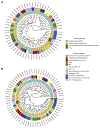Curation and expansion of Human Phenotype Ontology for defined groups of inborn errors of immunity
- PMID: 33991581
- PMCID: PMC9346194
- DOI: 10.1016/j.jaci.2021.04.033
Curation and expansion of Human Phenotype Ontology for defined groups of inborn errors of immunity
Abstract
Background: Accurate, detailed, and standardized phenotypic descriptions are essential to support diagnostic interpretation of genetic variants and to discover new diseases. The Human Phenotype Ontology (HPO), extensively used in rare disease research, provides a rich collection of vocabulary with standardized phenotypic descriptions in a hierarchical structure. However, to date, the use of HPO has not yet been widely implemented in the field of inborn errors of immunity (IEIs), mainly due to a lack of comprehensive IEI-related terms.
Objectives: We sought to systematically review available terms in HPO for the depiction of IEIs, to expand HPO, yielding more comprehensive sets of terms, and to reannotate IEIs with HPO terms to provide accurate, standardized phenotypic descriptions.
Methods: We initiated a collaboration involving expert clinicians, geneticists, researchers working on IEIs, and bioinformaticians. Multiple branches of the HPO tree were restructured and extended on the basis of expert review. Our ontology-guided machine learning coupled with a 2-tier expert review was applied to reannotate defined subgroups of IEIs.
Results: We revised and expanded 4 main branches of the HPO tree. Here, we reannotated 73 diseases from 4 International Union of Immunological Societies-defined IEI disease subgroups with HPO terms. We achieved a 4.7-fold increase in the number of phenotypic terms per disease. Given the new HPO annotations, we demonstrated improved ability to computationally match selected IEI cases to their known diagnosis, and improved phenotype-driven disease classification.
Conclusions: Our targeted expansion and reannotation presents enhanced precision of disease annotation, will enable superior HPO-based IEI characterization, and hence benefit both IEI diagnostic and research activities.
Keywords: HPO; diagnostic support; disease classification; genetic analysis; immunodeficiencies; inborn errors of immunity; ontology; patient matching; phenotype; rare diseases.
Copyright © 2021 The Authors. Published by Elsevier Inc. All rights reserved.
Conflict of interest statement
Disclosure of potential conflict of interest: The authors declare that they have no relevant conflicts of interest.
Figures





Similar articles
-
Curation and expansion of the Human Phenotype Ontology for systemic autoinflammatory diseases improves phenotype-driven disease-matching.Front Immunol. 2023 Sep 12;14:1215869. doi: 10.3389/fimmu.2023.1215869. eCollection 2023. Front Immunol. 2023. PMID: 37781402 Free PMC article.
-
Gene- and Disease-Based Expansion of the Knowledge on Inborn Errors of Immunity.Front Immunol. 2019 Oct 21;10:2475. doi: 10.3389/fimmu.2019.02475. eCollection 2019. Front Immunol. 2019. PMID: 31695696 Free PMC article.
-
An ontological foundation for ocular phenotypes and rare eye diseases.Orphanet J Rare Dis. 2019 Jan 9;14(1):8. doi: 10.1186/s13023-018-0980-6. Orphanet J Rare Dis. 2019. PMID: 30626441 Free PMC article.
-
Future of Therapy for Inborn Errors of Immunity.Clin Rev Allergy Immunol. 2022 Aug;63(1):75-89. doi: 10.1007/s12016-021-08916-8. Epub 2022 Jan 12. Clin Rev Allergy Immunol. 2022. PMID: 35020169 Free PMC article. Review.
-
Testing Two Patient Surveys for Diagnosing Rare Genetic Conditions [Internet].Washington (DC): Patient-Centered Outcomes Research Institute (PCORI); 2021 Jul. Washington (DC): Patient-Centered Outcomes Research Institute (PCORI); 2021 Jul. PMID: 39008648 Free Books & Documents. Review.
Cited by
-
Phenomic Analysis of Chronic Granulomatous Disease Reveals More Severe Integumentary Infections in X-Linked Compared With Autosomal Recessive Chronic Granulomatous Disease.Front Immunol. 2022 Jan 24;12:803763. doi: 10.3389/fimmu.2021.803763. eCollection 2021. Front Immunol. 2022. PMID: 35140711 Free PMC article.
-
The Immune Deficiency and Dysregulation Activity (IDDA2.1 'Kaleidoscope') Score and Other Clinical Measures in Inborn Errors of Immunity.J Clin Immunol. 2022 Apr;42(3):484-498. doi: 10.1007/s10875-021-01177-2. Epub 2021 Nov 19. J Clin Immunol. 2022. PMID: 34797428 Free PMC article.
-
Diffuse alveolar hemorrhage in children with interstitial lung disease: Determine etiologies!Pediatr Pulmonol. 2023 Apr;58(4):1106-1121. doi: 10.1002/ppul.26301. Epub 2023 Jan 13. Pediatr Pulmonol. 2023. PMID: 36588100 Free PMC article.
-
MOLGENIS VIP: an end-to-end DNA variant interpretation pipeline for research and diagnostics configurable to support rapid implementation of new methods.NAR Genom Bioinform. 2025 Jun 23;7(2):lqaf087. doi: 10.1093/nargab/lqaf087. eCollection 2025 Jun. NAR Genom Bioinform. 2025. PMID: 40585303 Free PMC article.
-
Implementation of Early Next-Generation Sequencing for Inborn Errors of Immunity: A Prospective Observational Cohort Study of Diagnostic Yield and Clinical Implications in Dutch Genome Diagnostic Centers.Front Immunol. 2021 Dec 21;12:780134. doi: 10.3389/fimmu.2021.780134. eCollection 2021. Front Immunol. 2021. PMID: 34992599 Free PMC article.
References
-
- Hernandez-Ibarburu G, Perez-Rey D, Alonso-Oset E, Alonso-Calvo R, de Schepper K, Meloni L, et al. ICD-10-CM extension with ICD-9 diagnosis codes to support integrated access to clinical legacy data. Int J Med Inform 2019;129:189–97. - PubMed
-
- Amberger J, Bocchini C, Hamosh A. A new face and new challenges for Online Mendelian Inheritance in Man (OMIM®). Hum Mutat 2011;32:564–7. - PubMed
Publication types
MeSH terms
Grants and funding
LinkOut - more resources
Full Text Sources
Other Literature Sources
Medical

